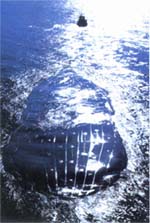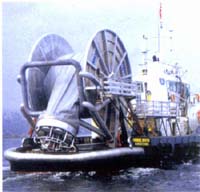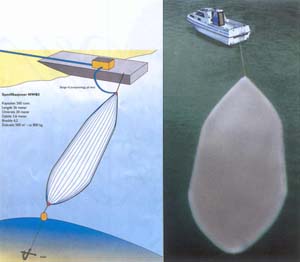|

 Fresh drinking water is a commodity, which
is often taken for granted in modern
countries, including the United Arab
Emirates. Simply turn on the tap and out
it flows. But although the world's supply
of fresh water is abundant and easily
enough to meet human demands for many
years, regional water scarcity is a common
problem in many parts of the world today.
The Middle East is a prime example.
Arid landscapes, low rainfall and fast
depleting underground water tables makes
the supply of fresh water one of the most
pressing issues facing regional
governments and municipalities today. Add
the fact that the Middle East has the
fastest growing population in the world
into the equation, and therefore an
ever-increasing demand for fresh water,
and the scale of the problem rises
further.
In the Gulf there is a heavy
dependence on desalination which requires
huge amounts of energy, but while
desalinated water is used domestically for
washing, filling swimming pools and
watering golf courses, it is rarely used
for drinking – bottled mineral and
drinking water are favoured by most.
While some countries have more
fresh water than they need, others do not,
which makes water a valuable - and
tradable - commodity. But in order to sell
water across borders and even seas,
transporting it becomes a major factor.
In an often quoted comment, the World
Bank's Water Resources Manager, John
Hayward, said in 1996: "One way or
another, water will be moved around the
world as oil is now."
Fresh drinking water is a commodity, which
is often taken for granted in modern
countries, including the United Arab
Emirates. Simply turn on the tap and out
it flows. But although the world's supply
of fresh water is abundant and easily
enough to meet human demands for many
years, regional water scarcity is a common
problem in many parts of the world today.
The Middle East is a prime example.
Arid landscapes, low rainfall and fast
depleting underground water tables makes
the supply of fresh water one of the most
pressing issues facing regional
governments and municipalities today. Add
the fact that the Middle East has the
fastest growing population in the world
into the equation, and therefore an
ever-increasing demand for fresh water,
and the scale of the problem rises
further.
In the Gulf there is a heavy
dependence on desalination which requires
huge amounts of energy, but while
desalinated water is used domestically for
washing, filling swimming pools and
watering golf courses, it is rarely used
for drinking – bottled mineral and
drinking water are favoured by most.
While some countries have more
fresh water than they need, others do not,
which makes water a valuable - and
tradable - commodity. But in order to sell
water across borders and even seas,
transporting it becomes a major factor.
In an often quoted comment, the World
Bank's Water Resources Manager, John
Hayward, said in 1996: "One way or
another, water will be moved around the
world as oil is now."
Proposed solutions to the problem have
included such far-fetched schemes as
towing icebergs from the Arctic to regions
where water is in most demand to the more
realistic, but costly, concepts of using
tanker ships or the construction of
pipelines. To convert an oil tanker to
transport fresh water all traces of crude
oil have to be eliminated using extensive
sand-blasting and resurfacing of the inner
hulls with stainless steel, while
pipelines become more expensive the
further they go.
There is, however, an alternative: the use
of giant bags - which can be filled with
fresh water in one country and towed
across the sea to another where water is
in greater demand - is fast being
recognised as the most cost-effective
method of bulk transportation of water.
The system works by filling a giant
bag with fresh water at a coastal filling
station in the supply country, which is
then towed by a tugboat to the receiving
country where the bag is unloaded. By
using three different bags, a cycle is
established whereby the newly delivered
bag is emptied at a discharging terminal
linked to the receiving country's water
distribution infrastructure as the tug
picks up the empty bag which was used
previously and returns to the filling
station where the third bag is already
filled and waiting for collection. This
enables the tug to be fully utilised while
ensuring the supply never runs dry.
Drinking water is lighter than seawater
and so the bag floats on the surface,
making it easier to tow, while empty bags
can be reeled onto the deck of the tug,
enabling it to return to the filling
station at high speed.

One of the
pioneers of this process is Nordic Water
Supply ASA (NWS), which signed its first
commercial contract in October 1997 with
the Ministry of Energy in Turkey to
transport fresh water to northern Cyprus,
which has been under Turkish Cypriot rule
since the 1974 invasion. Its main
competitor is Aquarius Holdings Limited,
which has tugged smaller bags from
mainland Greece to nearby resort islands
since 1997, helping the Greek tourism
industry cope with the increased demand
for drinking water during the peak holiday
season.
Nordic
Water Supply was established in Norway in
1979 and has been listed on the Oslo stock
exchange since 1998. It developed a
prototype water bag, which could hold
10,800 tonnes of water in 1994 and has
continued to develop its technology with
the introduction of 20,000 tonne bags in
1998 and 30,000 and 35,000 tonne bags in
2001.
"The basic premise for the endeavour
is the fact that the global demand for
water is increasing rapidly and that the
supply of water cannot keep pace with the
accelerating increase in demand in many
areas of the world," a company
spokesman said.
"The advantages of using bags
compared to ships are manifold. Investment
costs are, amongst other things,
significantly lower. Water transport based
on water bags also provides lower
operational costs due to lower fuel
consumption and crew requirements.
"Logistics related to the bag are
more effective, and requirements for port
facilities are substantially less
demanding than for ships. In total, these
advantages provide a significant cost
benefit compared to ships on short
transport hauls and, with the development
of larger bags, the advantages may be
maintained over longer distances."
NWS's 30,000 tonne water bag is 165 metres
long, 30 metres wide and seven metres deep
and contains enough water to supply
150,000 households with fresh water for
one day, although the company aims to
build a new bag in the coming years to
carry 100,000 tonnes, which at 350 metres
would be the length of a super tanker.
"The water bags are constructed from
high strength, lightweight, flexible and
reinforced plastic material," the
spokesman explained. "Front and stern
have a uniquely designed steel unit to
provide a safe and good hold for loading
and discharging water, as well as for
towing and anchorage.
"The water bags have a unique
and proven design which enables NWS to
manufacture and operate very large bags in
open waters with rough seas. A reliable
and steady supply of fresh water on a
continuous basis is ensured by always
having a full water bag ready in position
when one is empty. This is made possible
by operating three water bags by one tug.
One is loaded, one is in tow or being
returned and one is emptying at a
discharging terminal.
"The size of the water bag is decided
by a calculation based on the required
rate of delivery and towing distance and
the low towing drag results in very low
fuel consumption compared to more
traditional transport methods, thus
lowering the total cost."
Under its existing contract, NWS will have
transported about two million metric
tonnes of water from the Turkish mainland
to northern Cyprus in 2001 and aims to
expand to more than six million tonnes in
2002, as well as seeking new contracts in
other countries, including the United Arab
Emirates.
 However, it hasn't all been plain sailing.
The company had to send up a spotter plane
to locate some missing water in the
Mediterranean when a bag broke loose from
the tug in the middle of the night in
December 2000, prompting the witty
newspaper headline: 'Water Lost at Sea.'
It was eventually recovered and new bags
are now equipped with radar beacons, which
also help other ships avoid soft
collisions with the bag.
Early teething problems when the
Turkey to northern Cyprus operation began
in 1999 also resulted in several bags
being ripped open, especially at the
unloading terminals - although drinking
water is one of the world's few cargos,
where even a catastrophic spill causes no
pollution, except perhaps giving the fish
a strange fresh water taste.
However, it hasn't all been plain sailing.
The company had to send up a spotter plane
to locate some missing water in the
Mediterranean when a bag broke loose from
the tug in the middle of the night in
December 2000, prompting the witty
newspaper headline: 'Water Lost at Sea.'
It was eventually recovered and new bags
are now equipped with radar beacons, which
also help other ships avoid soft
collisions with the bag.
Early teething problems when the
Turkey to northern Cyprus operation began
in 1999 also resulted in several bags
being ripped open, especially at the
unloading terminals - although drinking
water is one of the world's few cargos,
where even a catastrophic spill causes no
pollution, except perhaps giving the fish
a strange fresh water taste.
But NWS has invested heavily in its water
bags and overcome its initial
problems to
establish a reliable and continuous
service to northern Cyprus since August
2000. It is now looking to expand further
to countries, where fresh water is most in
need, including other areas of the
Mediterranean, islands in the Caribbean
and the Middle East.
In October 1999 the world's population
finally reached six billion, having
doubled since 1960, according to the
United Nations. By 2025, it says, two
thirds of the world's population will have
limited access to fresh water and half
will have an acute shortage, while the
World Health Organisation has estimated
that water consumption will have to be
halved by 2025 if nations fail to address
imbalances in global water supply and
demand.
Just as camels evolved humps and
the Romans built aqueducts, it seems the
future of transporting water may lie in
giant, floating plastic bags.
|
